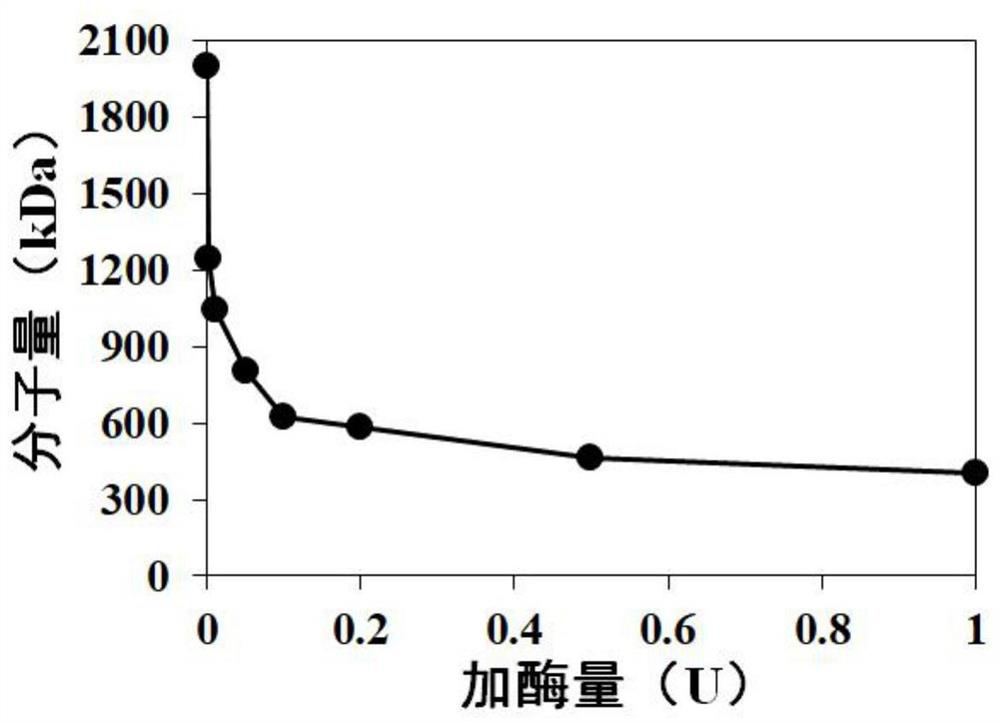Endo-1, 3-fucoidan enzyme and application thereof
A fucoidanase and enzyme activity technology, applied in the field of endo-1,3-fucoidanase, can solve the problems of low activity, high preparation cost, and difficult purification, and achieve high expression activity and high efficiency The effect of preparation
- Summary
- Abstract
- Description
- Claims
- Application Information
AI Technical Summary
Problems solved by technology
Method used
Image
Examples
Embodiment 1
[0022] Example 1: Heterologous expression of endo-1,3-fucoidanase in Escherichia coli
[0023] Culture of W. fucanilytica CZ1127 in 2216E medium TThe whole genome DNA was extracted until the end of the logarithm, and the upstream and downstream primers were designed according to the target gene, and PCR was carried out using the whole genome as a template. The PCR conditions were 94°C for 5 minutes, then 94°C for 30s, 50°C for 30s, 72°C for 60s, and 25 cycles. The PCR product was identified by nucleic acid electrophoresis, recovered and purified by tapping the gel to obtain the endo-1,3-fucoidanase gene fragment (such as figure 1 ). The pET-28a(+) plasmid and the endo-1,3-fucoidanase gene fragment obtained above were digested with BamHI and XhoI at the same time, digested at 37°C for 2 hours, verified by nucleic acid electrophoresis, and recovered by tapping gel Genes and target plasmids, the recovered products were ligated at 16°C for 1 hour using DNA ligase, the ligated pr...
Embodiment 2
[0024] Example 2: Heterologous expression of endo-1,3-fucoidanase in Bacillus subtilis
[0025] Design upstream and downstream primers, and retrieve the target sequence by PCR. The PCR process is the same as 1). The pMA5 vector and the target sequence were double-digested with HindIII and EcoRI at the same time, and the digested target gene was connected to the same digested vector, and the constructed expression vector was transformed into the expression host of Bacillus subtilis BS WB600 . Positive recombinants were screened on kanamycin resistance plates. The correct recombinant bacteria were inoculated in LB medium containing kanamycin resistance, and cultured at 37°C for 12h. Then transfer to LB medium containing kanamycin resistance with 1% inoculum amount, and culture at 37°C for 16h. The bacteria were collected by centrifugation, the resuspended bacteria were washed with buffer, and ultrasonically disrupted to obtain an intracellular enzyme solution, that is, a crud...
Embodiment 3
[0026] Example 3: Heterologous expression of endo-1,3-fucoidanase in Pichia pastoris
[0027] Design upstream and downstream primers, and retrieve the target sequence by PCR. The PCR process is the same as 1). The pPIC9K vector and the target sequence were digested with EcoRI and NotI at the same time, and the digested target gene was connected to the pPIC9K vector. The constructed recombinant plasmid was digested overnight with SalI enzyme and recovered, and the linearized and non-linearized plasmids were detected by electrophoresis. Linearized intelligence was electrotransformed into GS115 competent cells, and a single colony was extracted for PCR verification. The single clones with correct sequencing and antibiotic selection were cultured in YPD liquid medium at 30°C and 220rpm for 12h. Then inoculated in BMGY medium with pH 6.0, cultured at 30°C and 220rpm until OD600 was 5.0, centrifuged, then added BMMY medium with pH 6.0 for cultivation, added 0.5% methanol for 12h t...
PUM
| Property | Measurement | Unit |
|---|---|---|
| molecular weight | aaaaa | aaaaa |
Abstract
Description
Claims
Application Information
 Login to View More
Login to View More - R&D
- Intellectual Property
- Life Sciences
- Materials
- Tech Scout
- Unparalleled Data Quality
- Higher Quality Content
- 60% Fewer Hallucinations
Browse by: Latest US Patents, China's latest patents, Technical Efficacy Thesaurus, Application Domain, Technology Topic, Popular Technical Reports.
© 2025 PatSnap. All rights reserved.Legal|Privacy policy|Modern Slavery Act Transparency Statement|Sitemap|About US| Contact US: help@patsnap.com



